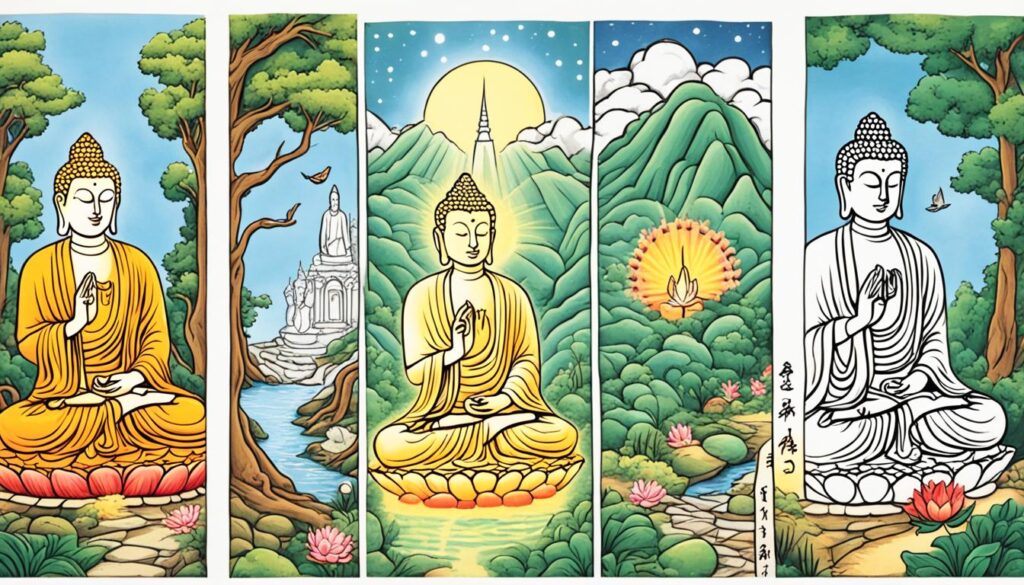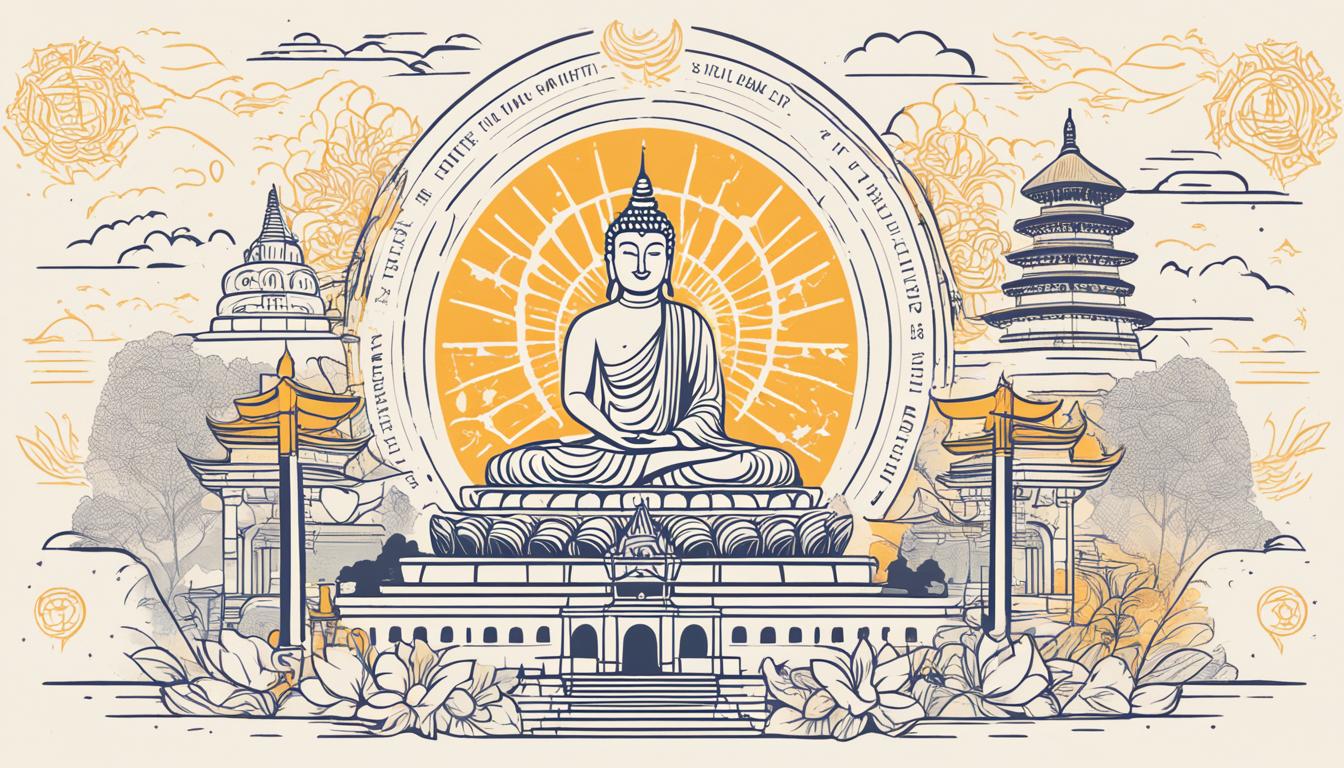Have you ever wondered where Buddhism is practiced today? Has it exclusively remained in its geographical birthplace, or has it spread its teachings worldwide? Prepare to have your preconceptions challenged as we embark on a journey to uncover the lesser-known locations where Buddhism thrives across the globe.
Key Takeaways:
- Buddhism is practiced in various countries around the world, extending beyond its origins in Asia.
- China, Japan, Korea, Vietnam, and Southeast Asian countries like Cambodia, Thailand, Myanmar, Bhutan, and Sri Lanka are prominent locations where Buddhism is predominantly practiced.
- Buddhism has also gained traction in Western countries, thanks to the adoption of Tibetan Buddhism and the influence of the Dalai Lama.
- The global impact and relevance of Buddhism can be seen through its teachings on mindfulness, compassion, and personal and societal harmony.
- Join us as we delve into the rich tapestry of Buddhism’s global presence, uncovering its influence and transformative teachings.
Branches of Buddhism
Buddhism encompasses several major branches or denominations that have developed over the centuries. These branches differ in their beliefs, practices, and geographical distribution, offering diverse paths towards spiritual enlightenment.
Mahayana Buddhism
The first major branch is Mahayana Buddhism, which is widely practiced in countries such as China, Japan, Korea, and Vietnam. Mahayana Buddhism emphasizes the concept of bodhisattvas, enlightened beings who postpone their own liberation to assist others in their journey towards awakening. Compassion and the pursuit of universal enlightenment for all beings are central principles in Mahayana Buddhism.
Theravada Buddhism
Theravada Buddhism, also known as the School of the Elders, is the prominent branch in Southeast Asian countries like Sri Lanka, Cambodia, Thailand, Laos, and Burma. This branch emphasizes the monastic lifestyle and the practice of meditation as a means to achieve liberation. Following the teachings of the Buddha as preserved in the Pali Canon, Theravada Buddhism places great importance on personal discipline and individual enlightenment.
Vajrayana Buddhism
Vajrayana Buddhism, often referred to as Tibetan Buddhism, is the predominant school in Tibet, Nepal, Bhutan, and Mongolia. It is characterized by its intricate rituals, esoteric teachings, and the use of various methods, such as tantra, to accelerate spiritual progress. Vajrayana Buddhism offers a faster path to enlightenment through the guidance of spiritual teachers, or lamas, and the utilization of advanced meditation techniques.
These three branches, Mahayana, Theravada, and Vajrayana, are the main denominations of Buddhism. Each branch has its unique teachings and practices, allowing individuals to find a spiritual path that resonates with their distinct needs and aspirations.

Key differences between the major branches of Buddhism:
| Branch | Central Principles | Main Geographical Influence |
|---|---|---|
| Mahayana | Emphasis on bodhisattvas and compassion | China, Japan, Korea, Vietnam |
| Theravada | Focused on monastic lifestyle and meditation | Sri Lanka, Cambodia, Thailand, Laos, Burma |
| Vajrayana | Intricate rituals and esoteric teachings | Tibet, Nepal, Bhutan, Mongolia |
Understanding the branches of Buddhism helps in appreciating the richness and diversity of the tradition. Each branch offers valuable insights and practices that contribute to the overall tapestry of Buddhist philosophy and spirituality.
Geography of Buddhism
Buddhism is a global religion and is practiced in various regions around the world. While its origins can be traced back to ancient India, Buddhism has spread far beyond its birthplace and has gained followers in many different countries and cultures.
In Asia, particularly in countries like China, Japan, Korea, Vietnam, Cambodia, Thailand, Myanmar, Bhutan, and Sri Lanka, Buddhism has a strong presence and is mainly practiced by the local population. These countries have a rich Buddhist heritage and are home to numerous temples, monasteries, and sacred sites.
In addition to Asia, Buddhism has also found a significant following in Western countries. Communities of Buddhist practitioners can be found in the United States, Canada, and various countries in Europe. As Buddhism continues to grow and gain recognition globally, it has become an integral part of the religious landscape in these regions.
The geographic location of Buddhism today reflects its diverse and inclusive nature. The teachings of Buddhism have resonated with people from different cultures and backgrounds, offering them a path to spiritual growth, inner peace, and self-discovery.

| Region | Major Countries |
|---|---|
| Asia | China, Japan, Korea, Vietnam, Cambodia, Thailand, Myanmar, Bhutan, Sri Lanka |
| North America | United States, Canada |
| Europe | United Kingdom, Germany, France, Netherlands |
| Australia | Australia, New Zealand |
| Latin America | Brazil, Argentina, Mexico |
Socially Engaged Buddhism
Socially Engaged Buddhism is a contemporary movement that has emerged in Vietnam during the 1960s. It is characterized by Buddhist practitioners actively addressing social, political, and ecological issues. Unlike traditional Buddhism, Socially Engaged Buddhism goes beyond personal spiritual development and emphasizes the importance of actively contributing to society.
This movement is not limited to monastic or lay members and includes individuals from Buddhist countries as well as Western converts. Socially Engaged Buddhism seeks to bring Buddhist values and principles into action to create positive change in the world.
In countries such as Cambodia, Thailand, Myanmar, Bhutan, and Sri Lanka, Socially Engaged Buddhism has gained prominence, with practitioners working towards developing Buddhist solutions to global problems. Examples of socially engaged Buddhist organizations include the Buddhist Peace Fellowship and the Engaged Buddhist Training Program.

| Benefits of Socially Engaged Buddhism | Examples of Socially Engaged Buddhism Organizations |
|---|---|
|
|
The Impact of Socially Engaged Buddhism
Socially Engaged Buddhism has a profound impact on individuals and communities. By actively engaging in social issues, it helps to create a more compassionate and just society. The teachings of Socially Engaged Buddhism inspire individuals to integrate mindfulness, compassion, and wisdom into their daily lives, contributing to the well-being of both themselves and others.
Tibetan Buddhism and its International Influence
Tibetan Buddhism, a form of Vajrayana Buddhism, has gained widespread recognition and influence globally, particularly due to the Chinese occupation of Tibet. This has led to the adoption of Tibetan Buddhist teachings and practices by practitioners from various countries, especially Westerners.
Tibetan Buddhism has transcended geographical boundaries, spreading its wisdom and teachings worldwide. The profound spiritual guidance and inspiration found within Tibetan Buddhist traditions have resonated deeply with individuals seeking personal growth and transformation.
The Dalai Lama, the revered spiritual leader of Tibetan Buddhism, has played a key role in promoting Tibetan Buddhism on an international scale. His teachings on compassion, mindfulness, and peace have captivated audiences around the world, transcending cultural and religious divides.

The international influence of Tibetan Buddhism can be seen in the establishment of numerous Tibetan Buddhist centers and monastic communities across different continents. These centers serve as spiritual sanctuaries where individuals gather to learn and practice Tibetan Buddhist teachings, fostering a global community rooted in compassion, wisdom, and spiritual growth.
The teachings and practices of Tibetan Buddhism have also permeated various aspects of Western culture, such as psychology, mindfulness-based therapies, and the exploration of consciousness. The profound impact of Tibetan Buddhism can be witnessed in the transformative journey of individuals embracing its teachings.
As Tibetan Buddhism continues to expand its international reach, it offers seekers of truth and enlightenment a path of wisdom and compassion, representing a profound force for personal and global transformation.
Buddhist Teachings and Insights
Buddhism offers profound teachings and insights that hold great relevance and applicability in modern society. These teachings encompass various aspects of life and provide invaluable guidance for personal and societal transformation.
Mindfulness: Cultivating Awareness and Presence
One of the prominent aspects of Buddhist practice is mindfulness. Mindfulness involves being fully present in the current moment, paying attention to our thoughts, feelings, and sensations with non-judgmental awareness. Through mindfulness, we become more attuned to the present moment, allowing us to develop a deeper understanding of ourselves and the world around us.
Mindfulness has gained popularity worldwide due to its profound benefits for mental well-being. It helps reduce stress, anxiety, and depression, and enhances our overall sense of peace and contentment. By practicing mindfulness, we can cultivate a greater sense of clarity, focus, and emotional resilience in the face of life’s challenges.
Compassion: Embracing Empathy and Kindness
Compassion is another fundamental principle in Buddhism. It involves cultivating empathy and kindness towards oneself and others. Buddhist teachings emphasize the interconnectedness of all beings and encourage us to extend compassion to everyone, not just to those close to us.
Through the practice of compassion, we develop the capacity to understand and alleviate the suffering of others. It enables us to respond to difficult situations with kindness and understanding, fostering harmonious relationships and promoting a more compassionate society.
Buddhist Philosophy: Insights into Wisdom and Liberation
Buddhist philosophy offers profound insights into the nature of human existence and the path to liberation. It explores concepts such as suffering (dukkha), impermanence (anicca), and the absence of a permanent self (anatta). Through contemplation and reflection, we gain a deeper understanding of the transient nature of reality and the causes of suffering.
Buddhist philosophy also provides guidance on the path to liberation. It outlines the Noble Eightfold Path, which encompasses aspects such as Right View, Right Intention, Right Speech, Right Action, Right Livelihood, Right Effort, Right Mindfulness, and Right Concentration. By following this path, we cultivate wisdom, ethical conduct, and mental development, ultimately achieving liberation from suffering.
To truly understand and benefit from these teachings, it is important to explore and practice them with an open mind and heart. The integration of mindfulness, compassion, and Buddhist philosophy can lead to profound personal growth, increased well-being, and a more compassionate and harmonious society.

The Four Noble Truths
The Four Noble Truths are foundational teachings in Buddhism that provide profound insights into the nature of suffering and offer a path to liberation. These truths serve as a guiding light, illuminating the human experience and providing a framework for understanding and overcoming the challenges of existence.
“The truth of suffering” (dukkha) acknowledges the universal reality of suffering in life. From physical pain and mental anguish to the dissatisfaction that permeates our daily existence, suffering is an intrinsic part of the human condition. It encompasses both obvious forms of suffering, such as illness and loss, as well as the subtle discontent that arises from our continuous craving and clinging.
“The causes of suffering” (the arising of dukkha) shed light on the underlying sources of our suffering. According to Buddhism, the primary causes of suffering are attachment (to desired outcomes or experiences) and aversion (to undesirable situations or sensations). These attachments and aversions stem from our ignorance of the impermanent and interconnected nature of reality. By clinging to transient phenomena and resisting change, we perpetuate our suffering.
“The end of suffering” (the stopping of dukkha) points to the possibility of liberation from the cycle of suffering. It reveals that suffering can cease by removing the very causes that give rise to it. Through mindful awareness, insight, and the cultivation of wisdom, it becomes possible to free ourselves from the pattern of attachment and aversion that perpetuates our suffering.
“The path leading to the end of suffering” (the path to freedom from suffering) outlines the Eightfold Path, a comprehensive framework for personal transformation. This path encompasses right view, right resolve, right speech, right action, right livelihood, right effort, right mindfulness, and right meditation. Following this path allows individuals to cultivate ethical conduct, develop mental clarity, and attain spiritual realization.
| Noble Truth | Aspect | Description |
|---|---|---|
| 1. The Truth of Suffering (Dukkha) | The Universality of Suffering | Recognizing that suffering is an inherent part of human existence. |
| The Various Forms of Suffering | Understanding the different forms of suffering, both obvious and subtle. | |
| 2. The Causes of Suffering (The Arising of Dukkha) | Attachment | Highlighting the role of attachment and craving in the generation of suffering. |
| Aversion | Recognizing how aversion and resistance contribute to our suffering. | |
| 3. The End of Suffering (The Stopping of Dukkha) | Freedom from Attachment | Realizing that liberation from suffering is attainable through the cessation of attachment. |
| Freedom from Aversion | Understanding that letting go of aversion brings an end to suffering. | |
| 4. The Path to Freedom from Suffering | The Eightfold Path | Outlining the eight aspects of the path that lead to the liberation from suffering. |
| Cultivating Wisdom and Ethical Conduct | Exploring the development of wisdom, ethical behavior, and meditation practices. |

By embracing the Four Noble Truths, individuals can embark on a transformative journey of self-discovery and liberation. The teachings of Buddhism offer invaluable guidance on how to navigate the challenges of existence, liberate ourselves from suffering, and cultivate a profound sense of peace and well-being.
Analogy of Understanding the Four Noble Truths
The Four Noble Truths in Buddhism can be understood using a medical analogy, providing a unique perspective on the nature of suffering and its resolution. This analogy draws parallels between the process of diagnosis, identification of causes, treatment, and recovery in medicine with the Four Noble Truths in Buddhism.
Truth 1: Diagnosis
Just as a doctor diagnoses an illness or condition, Truth 1 in Buddhism acknowledges the presence of suffering (dukkha) in human existence. It is a recognition that suffering is a universal experience and an integral part of life.
Truth 2: Identification of Causes
Similar to identifying the underlying causes of an illness, Truth 2 in Buddhism investigates the root causes of suffering. It reveals that attachment, desire, and ignorance are the fundamental causes that perpetuate the cycle of suffering.
Truth 3: Possibility of Ending Suffering
Just as medicine offers the possibility of healing and recovery, Truth 3 in Buddhism emphasizes the potential for ending suffering. It provides hope and reassurance that liberation from suffering is attainable through the cessation of attachment, desire, and ignorance.
Truth 4: Path to Freedom
Similarly, the path to recovery and treatment in medicine is outlined for patients, Truth 4 in Buddhism outlines the Noble Eightfold Path as the means to achieve freedom from suffering. The Noble Eightfold Path consists of moral conduct, mental discipline, and wisdom, guiding individuals towards liberation and enlightenment.
This medical analogy highlights the practical and transformative nature of the Four Noble Truths. Just as medical knowledge and treatment can alleviate physical ailments, the Four Noble Truths provide a framework for understanding and addressing the universal human condition of suffering, leading to personal and spiritual growth.

| Medical Analogy | Four Noble Truths |
|---|---|
| Diagnosis | Truth 1: Acknowledgment of suffering |
| Identification of Causes | Truth 2: Recognition of the underlying causes |
| Treatment | Truth 3: Possibility of ending suffering |
| Recovery | Truth 4: Path to freedom from suffering |
Buddhist Theology and Metaphysical Speculations
Buddhist theology diverges from many other religions by not placing significant emphasis on metaphysical speculations. Unlike other belief systems, the Buddha himself did not concern himself with topics such as the existence of god, the afterlife, or creation stories. Instead, Buddhism is rooted in practical teachings and the exploration of the nature of suffering and liberation. While different Buddhist traditions have incorporated metaphysical elements over time, the core of Buddhist teaching remains focused on ethical principles and personal transformation.
Karma and Samsara in Buddhism
In Buddhism, the concept of karma and samsara plays a crucial role in understanding the cycle of existence. Unlike other religions, Buddhism does not believe in a permanent soul or self. Instead, it teaches that individuals are bound to the cycle of suffering, known as samsara, through the implications of their actions influenced by ignorance, desire, and hatred.
Karma, a fundamental principle in Buddhism, refers to the moral law of cause and effect. It suggests that every action, intention, and thought has consequences, shaping one’s life and future experiences. Positive actions and intentions lead to positive outcomes, while negative actions and intentions result in suffering.
According to Buddhist teachings, individuals undergo countless cycles of birth, death, and rebirth within samsara. This continuous process is driven by the accumulation of karma throughout lifetimes. Each rebirth is influenced by the intentions, actions, and consequences of past lives, determining the conditions and circumstances of the new life.
The cycle of samsara is perpetuated by attachments, cravings, and ignorance, creating a never-ending cycle of suffering. However, Buddhism offers a path to liberation from this cycle, known as nirvana. Nirvana is the ultimate goal and represents the cessation of suffering, the end of the cycle of rebirth, and the attainment of enlightenment.

The teachings of Buddhism guide individuals in understanding the interconnectedness of their actions and the consequences they bring. By cultivating mindfulness, compassion, and wisdom, practitioners can break free from the cycle of suffering and reach the state of nirvana.
| Karma and Samsara in Buddhism | Nirvana |
|---|---|
| Concept of cause and effect | State of liberation from suffering |
| Actions driven by ignorance, desire, and hatred | End of the cycle of rebirth |
| Continuous cycle of birth, death, and rebirth | Attainment of enlightenment |
| Accumulation of karma throughout lifetimes | Cessation of suffering |
| Attachments, cravings, and ignorance | Ultimate goal in Buddhism |
The Eightfold Path to Liberation
The Eightfold Path is the path leading to the cessation of suffering and the attainment of liberation in Buddhism. It consists of eight aspects that guide practitioners in cultivating wisdom, ethical conduct, and mental development. By following the Eightfold Path, individuals can align their lives with Buddhist principles and work towards spiritual growth and enlightenment.
1. Right View
Right view involves understanding the true nature of reality, including the impermanence of all things and the interconnectedness of life. It is the foundation for developing a clear and accurate understanding of the world and oneself.
2. Right Resolve
Right resolve refers to having the right intentions and aspirations. It involves cultivating wholesome and compassionate thoughts and letting go of harmful desires and attachments.
3. Right Speech
Right speech emphasizes the importance of speaking truthfully, kindly, and non-harmfully. It encourages practicing mindful and conscious communication, avoiding gossip, slander, and harmful speech.
4. Right Action
Right action involves acting in ways that are ethical, compassionate, and beneficial to oneself and others. It entails refraining from killing, stealing, and engaging in harmful actions.
5. Right Livelihood
Right livelihood focuses on engaging in a livelihood that is ethical, honest, and aligned with the principles of Buddhism. It encourages practitioners to avoid occupations that cause harm to others or involve unethical practices.
6. Right Effort
Right effort involves cultivating wholesome qualities and working diligently to overcome unwholesome tendencies. It includes making an effort to cultivate positive states of mind, abandon negative habits, and develop mindfulness and concentration.
7. Right Mindfulness
Right mindfulness entails being fully present in the present moment and developing awareness of one’s thoughts, emotions, and bodily sensations. It involves cultivating a non-judgmental and compassionate awareness of oneself and the world around them.
8. Right Meditation
Right meditation, also known as right concentration, refers to the practice of meditation to develop focused and concentrated states of mind. It involves various meditation techniques aimed at cultivating calmness, insight, and mindfulness.
By incorporating these eight aspects into one’s life, individuals can progress along the path towards liberation and the ultimate goal of ending suffering. The Eightfold Path serves as a comprehensive guide for cultivating wisdom, ethical behavior, and mental development in the pursuit of spiritual growth and enlightenment.

The Influence of Buddhism in China
Buddhism has had a profound and lasting impact in China, making it one of the most significant countries for the practice and development of Buddhism. With a large population of Buddhists residing in the country, it is estimated that about half of the world’s Buddhists call China home. The introduction of Buddhism to China can be traced back to its transmission from India, and over the centuries, it has undergone adaptation and assimilation into the rich fabric of Chinese culture and society.

One can witness the influence of Buddhism in China through the vast number of Buddhist temples and monasteries that dot the landscape of the country. These sacred sites serve as spiritual havens, offering a place for devotees to practice meditation, seek enlightenment, and connect with the teachings of Buddhism. From famous landmarks like the Shaolin Temple, known for its association with martial arts, to the serene beauty of the Mogao Caves in Dunhuang, these architectural marvels stand as testaments to the enduring legacy of Buddhism in China.
Furthermore, the teachings of Buddhism continue to shape the spiritual and cultural landscape of China. Buddhist philosophy and principles, such as mindfulness, compassion, and the pursuit of inner peace, resonate deeply with the Chinese people. These teachings provide guidance and wisdom on navigating the complexities of life and fostering harmony within oneself and society as a whole.
The enduring presence of Buddhism in China serves as a reminder of the religion’s profound influence on Chinese spirituality, art, philosophy, and daily life. It continues to captivate the hearts and minds of millions, offering solace, wisdom, and a path to enlightenment in the modern world.
The Buddhist Community in the United States
Buddhism has found a meaningful presence in the United States, attracting a diverse and burgeoning community of practitioners. With an estimated representation of about 1% in the adult population, Buddhists in the United States are a growing spiritual force. This community consists not only of Asian Americans but also of individuals who have embraced Buddhism as converts, reflecting the inclusive nature of the religion.
The landscape of Buddhism in America is adorned with numerous Buddhist temples and organizations, spread across the country. These sacred spaces provide havens for practice, study, and community engagement, catering to the needs of both new and seasoned practitioners.
For individuals seeking solace, wisdom, and connection, the Buddhist community in the United States serves as a vibrant gathering ground, offering opportunities for personal growth, cultural exchange, and spiritual exploration.

Buddhist Temples in the United States
Table:
| State | Number of Temples |
|---|---|
| California | 150 |
| New York | 75 |
| Texas | 50 |
| Illinois | 40 |
| Hawaii | 35 |
Note: The table displays the number of Buddhist temples in various states across the United States. This data provides insights into the distribution of Buddhist temples throughout the country, emphasizing the diverse and widespread presence of Buddhism in America.
Buddhism and Age Demographics
When it comes to age demographics, Buddhists tend to have an older demographic compared to the general population. The median age of Buddhists is 36, which is slightly higher than the global median age of 30. This suggests that Buddhism has a particular appeal to individuals who are seeking spiritual guidance and wisdom later in life.
The older age distribution among Buddhists can be attributed to the long history and traditions of Buddhism, which has been practiced for thousands of years. Over time, the teachings of Buddhism have resonated with individuals looking for deeper meaning and inner peace. As people mature and gain life experience, they may seek spiritual practices that provide guidance and insights into the complexities of existence.
It is also worth noting that Buddhism’s emphasis on mindfulness, compassion, and personal transformation may attract individuals who are seeking a spiritual path later in life. These teachings offer practical tools for navigating life’s challenges and cultivating a sense of inner well-being.
The table below provides a visual representation of the age distribution among Buddhists:
| Age Group | Percentage of Buddhists |
|---|---|
| 18-24 | 10% |
| 25-34 | 15% |
| 35-44 | 20% |
| 45-54 | 25% |
| 55 and above | 30% |
As the table illustrates, the percentage of Buddhists increases with age, indicating that Buddhism may have a particularly strong appeal to older individuals. This suggests that the teachings of Buddhism continue to resonate and provide valuable guidance for personal growth and spiritual development throughout different stages of life.

Buddhism’s Global Impact and Relevance
Buddhism has had a profound influence across the globe, transcending physical boundaries and permeating diverse cultures. Its teachings and practices have gained recognition worldwide for their ability to address modern challenges and promote personal and societal harmony. Let’s explore how Buddhism’s impact extends beyond geographical locations, shaping individuals and societies in profound ways.

Buddhism’s Teachings for Personal and Societal Harmony
Buddhism offers invaluable teachings that foster personal and societal well-being. One of the key principles is mindfulness, which involves cultivating deep awareness and presence in every moment. This practice enables individuals to navigate the complexities of modern life with clarity and focus, reducing stress, and enhancing overall mental well-being.
Compassion, another core teaching of Buddhism, emphasizes empathy and kindness towards oneself and others. It encourages individuals to develop a profound sense of interconnection and care for all living beings, promoting harmony and cooperation within communities and across borders.
Buddhism’s Impact on Modern Challenges
Buddhism provides insightful perspectives and practical approaches to addressing the modern challenges we face. Its teachings offer profound insights into the nature of suffering, highlighting the impermanence and interconnectedness of all things. By embracing these teachings, individuals can gain a deeper understanding of the root causes of human suffering and explore paths to alleviating and transcending these challenges.
In an increasingly interconnected and fast-paced world, Buddhism’s emphasis on ethical conduct, mindfulness, and compassion serves as a guide for ethical decision-making and fostering social responsibility. By promoting values such as non-violence, environmental sustainability, and social justice, Buddhism contributes to building a more compassionate and sustainable global society.
The Global Reach of Buddhism
Buddhism’s influence spans continents, with devoted practitioners and vibrant communities found in various parts of the world. While Asia remains the birthplace and spiritual home of Buddhism, it has gained significant traction in Western countries as well. Buddhist temples, meditation centers, and monastic communities can be found from China and Japan to the United States, Canada, and Europe.
Buddhism’s teachings and practices continue to resonate with individuals from all walks of life, transcending cultural and religious boundaries. Its universal relevance lies in the timeless wisdom it imparts, enabling people to find meaning, inner peace, and enlightenment in an ever-changing world.
| Region | Key Countries |
|---|---|
| Asia | China, Japan, Korea, Vietnam, Cambodia, Thailand, Myanmar, Bhutan, Sri Lanka |
| North America | United States, Canada |
| Europe | United Kingdom, Germany, France, Netherlands |
| South America | Brazil, Argentina, Chile |
| Oceania | Australia, New Zealand |
Conclusion
In conclusion, Buddhism is a profound and influential global religion practiced in various countries worldwide, with major branches such as Mahayana, Theravada, and Vajrayana. The teachings of Buddhism, including the Four Noble Truths and the Eightfold Path, offer invaluable guidance for understanding and addressing the nature of suffering.
China, Japan, Korea, and Vietnam are among the countries where Buddhism is most prevalent, but its influence extends far beyond geographical boundaries. Buddhism’s teachings of mindfulness, compassion, and personal and societal harmony have made a significant impact on individuals and societies globally.
By emphasizing principles of wisdom, ethical conduct, and mental development, Buddhism continues to resonate with those seeking inner peace, enlightenment, and a meaningful existence. The universal applicability of its teachings makes Buddhism relevant not only in spiritual pursuits but also in addressing the challenges of the modern world.

